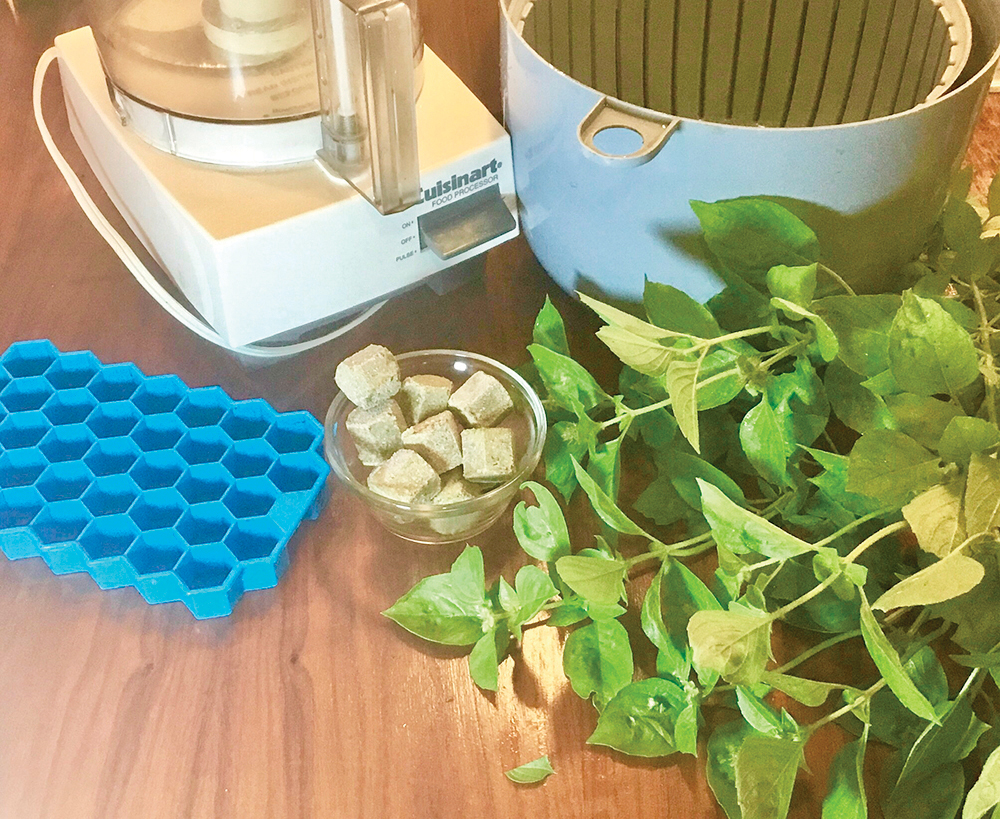
Basil is in season about now. The basil I grow in my garden has begun to bolt (grow flowers), which happens about mid-August through September, so I know it’s harvest time. And that means bunches of fresh basil will be making their way to the farmer’s markets and specialty stores. Pick some up, and try this recipe. Make one large batch, freeze it into small cubes, and use it up slowly over the year.
There’s nothing like homemade pesto. It’s far, far better than the jarred varieties you see on supermarket shelves. It is particularly delicious on pasta, but you can also use it with rice, in some soups, or even spread on a tortilla with a bit of cheddar melted on. If you make your pesto pareve, adding parmesan cheese only at the last minute, you can make fancy dishes like Pesto Chicken any time you want throughout the year, with little fuss.
It’s not difficult to make pesto if you have a salad spinner and a Cuisinart-type food processor. You can easily scale this recipe up or down as you wish, so your first time you might try a small batch. And don’t worry about measuring precisely; nearly any ingredient may be halved or doubled and it will still be great.
Classic Pesto alla Genovese
Ingredients
- A few bunches of basil leaves, 12-16 ounces total
- 6 ounces nuts — pignoli / pine nuts are classic; almonds also work
- 2 medium cloves garlic, peeled, cut into chunks
- about 1 cup olive oil, preferably extra virgin
- 2 tablespoons kosher salt or more, to taste
Separate the basil leaves from the thick stems, and discard the stems. (I never worry about a few thin stems, they chop up just fine.) Check for bugs as you go. Rinse the leaves in a salad spinner a few times. Spin the leaves dry, and set aside.
Put the garlic, nuts, salt and about half a cup of olive oil into the food processor. Pulse until it seems well mixed. Then add the basil, a handful at a time, and run the food processor until it is fully chopped and paste-like. Add olive oil whenever it gets so thick that it stops moving freely.
At this point it’s done. It keeps several weeks in the refrigerator, but I prefer to freeze it. I spoon the pesto into flexible silicone ice cube trays with cells about 1/2” in size, and freeze them for a day or two. Then I pop out all the little cubes of pesto into a zipper-sealed plastic bag, which I keep in my freezer throughout the year. Whenever I want a bowl of pesto pasta, I drop one or two frozen cubes into a bowl, microwave it for 15 seconds or so to defrost it, add the noodles, stir, and enjoy. Oh, and I always keep parmesan cheese on hand, along with more olive oil and salt, to add as needed.
Try Growing Basil
You may have seen your supermarket selling large bowls of basil seedlings, about 50 all in one pot, in late spring. That’s when I buy them, and I plant a few dozen around my garden. (If you keep them all in that one pot, they will die from overcrowding, so you must separate and replant them.) Of course, any garden store sells single basil plants in early spring. When the plants start to grow knobby flower buds at their tips, around August, clip off those buds. Then you can either harvest the basil leaves, or let the plants grow a little longer.
It’s somewhat tedious to grow basil from seeds, but if you want to try different types, there are many seed companies such as SuperSeeds.com that sell varieties like Thai Basil, Lime Basil, Cinnamon Basil, etc. But I prefer the standard ‘Italian large leaf’ variety.
Beyond Pesto: South American Chimichurri
Once you develop a taste for basil pesto, you can branch out into other sauces. I admit, I didn’t care for cilantro until I tried this recipe, but now I’m a fan. I make chimichurri a couple times a year, without bothering to freeze it, and I use it up quickly on pasta.
Ingredients
- 1 bunch flat leaf parsley
- 1 bunch cilantro
- 2 or 3 garlic cloves
- 1/3 cup regular or extra virgin olive oil
- 2 tablespoons vinegar (any type you like)
- 1 tablespoon kosher salt
- 2 teaspoons dried oregano (optional)
- A dash of red pepper or sriracha (optional)
Remove and discard the stems. Rinse and dry the leaves in a salad spinner. Add everything into a food processor, and blend, adding olive oil as needed to keep it flowing. If you really hate the taste of cilantro, make an all-parsley variety. But try the cilantro version at least once. It’s an acquired taste you may end up liking.
There Are Dozens of
Pesto Varieties
Rather than give you recipe after recipe, I urge you to search the Internet for “pesto varieties,” and you will find websites like the-pasta-project.com that lists 15 pesto varieties made with unexpected primary ingredients such as sun-dried tomatoes, walnuts, ricotta cheese, onion, roasted red pepper, arugula, mint or black olives. But start with the classic “Genovese” recipe above. If your kids love it as much as mine do, pasta with pesto will become a favorite super-easy meal or side dish.
Dan Dyckman received his M.D. from Brown University in 1984, followed by an internship year in a Connecticut hospital, a master’s degree in biostatistics from the Harvard School of Public Health in 1987, and a computer science degree from UC Berkeley in 1991. He is now retired.










